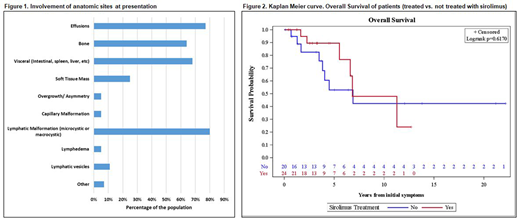Abstract

Background: Kaposiform lymphangiomatosis (KLA) is a rare, aggressive lymphatic malformation that can lead to significant morbidity and mortality (Croteau et al 2014). First described as a distinct entity from generalized lymphatic anomaly (GLA) in 2014, KLA is histologically defined by spindled "kaposiform" endothelial cells associated with abnormal proliferation of lymphatic vessels. High risk features include pleural/pericardial effusions and coagulopathy. Respiratory failure, infections, and hemorrhage are common causes of death. In the largest case series of patients with KLA (n=20), five-year survival was 51%. Mean interval between diagnosis and death was 2.75 years. In recent years, the oral agent sirolimus has been used to treat KLA as a single agent or in combination with steroids and vincristine. No update has been published about overall outcomes for patients since the more widespread use of sirolimus.
Methods: We conducted a retrospective chart review of 44 patients with biopsy-proven KLA referred to the Vascular Anomalies Center at Boston Children's Hospital and Cincinnati Children's Hospital Medical Center between 1995 and 2018. Twenty patients were previously analyzed in a retrospective review. Patient data were gathered through the electronic medical record and and the Lymphatic Anomalies Registry. Response to treatment was defined by clinical assessment via extraction from the medical record, improvement in patient or parent-reported quality-of-life, improved coagulopathy, and decreased size of lesions on imaging. Toxicities were graded according to the NIH CTCAE grading scale. Clinical outcomes were evaluated up until July 2018.
Results: Among 44 patients with KLA, the median age at onset of symptoms was 7 years (range=0-40.6 years). The median time from development of first symptoms to diagnosis of KLA was 16.4 months (range=0-12 years). Seventy-eight percent of patients had pleural or pericardial effusions at presentation (Figure 1). Anatomic involvement varied, with 65% of patients having bony involvement and 68% of patients having visceral disease. Bleeding was also common, with 14% of patients requiring transfusions of blood products. Twenty-four (56%) of 44 patients were treated with sirolimus. Of those 24 patients, 20 (83%) patients reported ever having a sustained response to sirolimus (>6 months) based on our criteria. Despite improvement in disease symptoms, there was no significant difference in overall survival between patients who were treated with sirolimus and those who were not (log-rank p=0.62; Figure 1).
Of the 44 patients evaluated in our study, fourteen died. Nine of the patients did not receive sirolimus (they died prior to its use in treating vascular anomalies). Of the 5 patients who received sirolimus and subsequently died, one reported marked improvement in his quality of life, but died from a pneumothorax during chest tube placement for a pleural effusion. The other patient who responded died from respiratory failure after a period of non-adherence with taking sirolimus. The remaining three patients did not respond to sirolimus and died of multi-organ failure. Among the 14 patients who died, the median time from diagnosis to death was 2.2 years (range 0.2- 7.1 years).
Among 24 patients treated with sirolimus, 16 (67%) patients were treated concurrently with either vincristine (n=10) and/or steroids (n=15). Eight patients had sustained response with sirolimus alone. Minimal side effects were observed; there was only one grade 3 thrombocytopenia that did not require cessation of sirolimus. Sixteen patients remained on sirolimus at last follow-up.
Conclusions: Most patients treated with sirolimus report stabilization of their disease symptoms and improvement in quality of life. Sirolimus is well-tolerated and most patients who respond remain on sirolimus as a form of chronic therapy. However, overall mortality for KLA remains high, even for those patients treated with sirolimus. More research is needed to investigate possible risk factors for poor outcomes. Investigation regarding phenotype-genotype correlation for KLA is ongoing, with the hope of identifying additional treatment options. In our study, there was a gap of > 1 year between time of symptom onset and diagnosis of KLA, highlighting a need for increased awareness of this unique disease entity and prompt referral of patients to a center with expertise in vascular anomalies.
No relevant conflicts of interest to declare.
Author notes
Asterisk with author names denotes non-ASH members.

This icon denotes a clinically relevant abstract


This feature is available to Subscribers Only
Sign In or Create an Account Close Modal